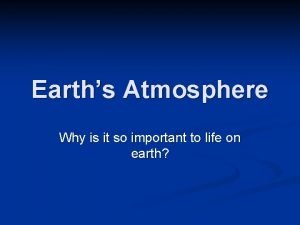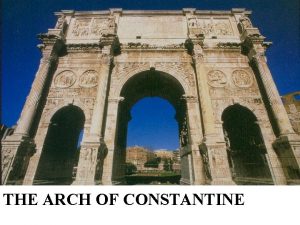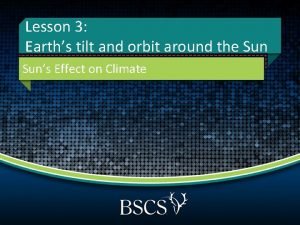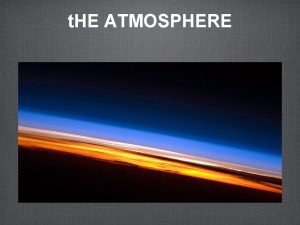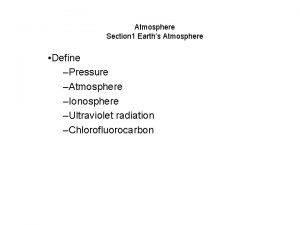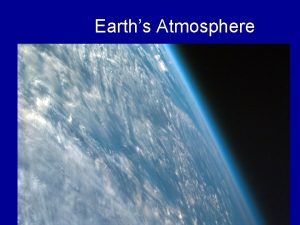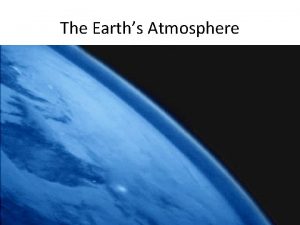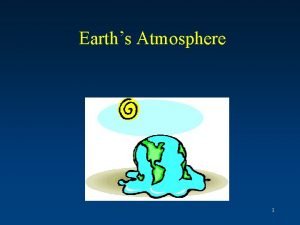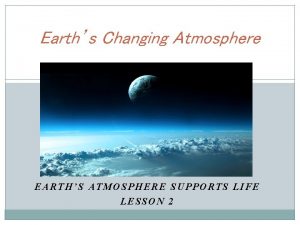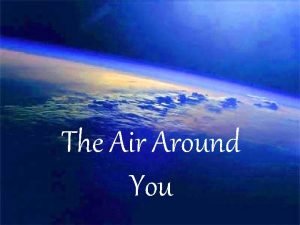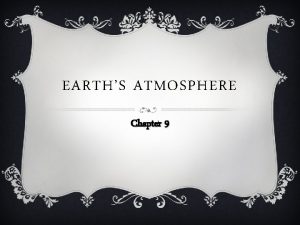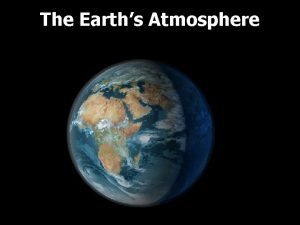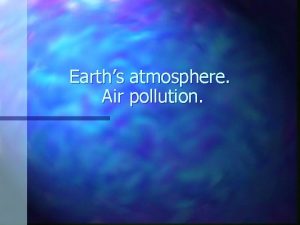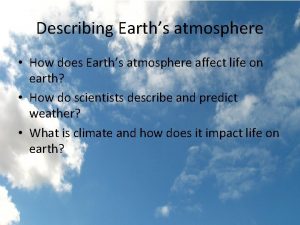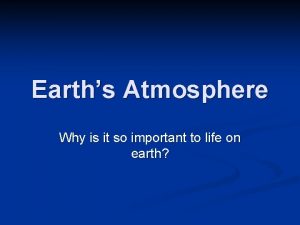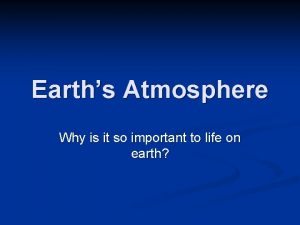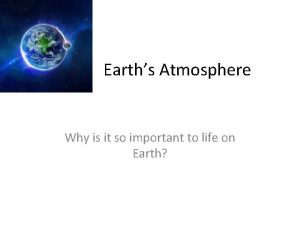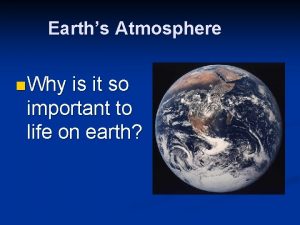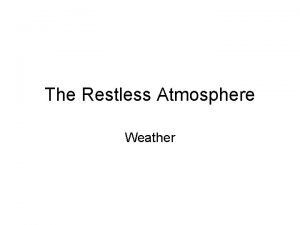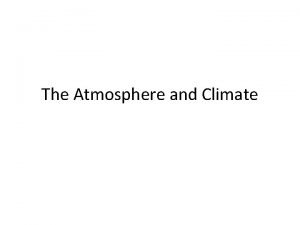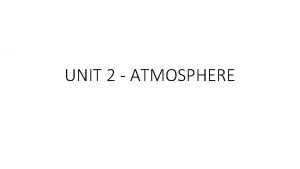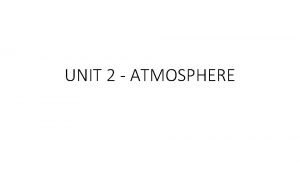Earths Atmosphere Why is it important Without its



























- Slides: 27

Earth’s Atmosphere

Why is it important? �Without its atmosphere, Earth would be a very different planet. �Gases in the atmosphere allow: plants to photosynthesize animals and plants to engage in respiration.

Water Cycle �Role of the atmosphere: Water vapor, which is an atmospheric gas, is an essential part of the water cycle.

Weather �All weather takes place in the atmosphere. �Weather describes what the atmosphere is like at a specific time and place. �Changes day to day. �This can include: Temperature Wind Precipitation

Climate �Climate is the long-term average of weather in a particular spot. �Example: Weather for a particular winter day in Tucson, Arizona, may include snow, however, the climate of Tucson is generally warm and dry.

Ozone �Ozone is a molecule composed of three oxygen atoms, (O 3). �Located in the upper atmosphere. �Absorbs high-energy ultraviolet (UV) radiation coming from the Sun. Without ozone for protection, only the simplest life forms would be able to live on Earth.

Atmospheric Gases �Keep Earth's temperatures within an acceptable range. �Greenhouse gases trap heat in the atmosphere so they help to moderate global temperatures. �Without an atmosphere with greenhouse gases, Earth's temperatures would be frigid at night and scorching during the day. �Important greenhouse gases include: carbon dioxide, methane, water vapor, and ozone.

Composition of Air �Nitrogen and oxygen make up 99% of the atmosphere. �Carbon dioxide and water vapor are very important , but a minor component.

Humidity �Humidity is the amount of water vapor in the air. �Equatorial regions have higher humidity Air temperatures are higher and warm air can hold more moisture than cooler air. Humidity is lower near the polar regions because air temperature is lower.

Atmospheric Pressure �Air pressure is the force of air weighing down over a unit of area. �At higher altitudes, air pressure is lower. This bottle was closed at an altitude of 3, 000 meters where air pressure is lower. When it was brought down to sea level, the higher air pressure caused the bottle to collapse.

Layers of the Atmosphere �Troposphere �Stratosphere �Mesosphere �Thermosphere �Exosphere

Layers of the Atmosphere �Divided into layers based on how the temperature in that layer changes with altitude. �The temperature gradient in each layer is determined by the heat source of the layer.

� The layers of the atmosphere appear as different colors in this image from the International Space Station.

Troposphere �The lowest layer that is closest to Earth’s surface. �Where most of the atmospheric gases are located. �All of the planet’s weather occurs here. �Heated from the ground, so temperature decreases with altitude. Because warm air rises and cool air sinks, the troposphere is unstable.

Temperature Inversion �When air temperature increases with altitude. Warm air sits over cold air. �Inversions form: Over land at night or in winter when the ground is cold. � The cold ground cools the air that sits above it, making this low layer of air denser than the air above it. Near the coast where cold seawater cools the air above it. � When that denser air moves inland, it slides beneath the warmer air over the land.

Thermal Inversion � Since temperature inversions are stable, they often trap pollutants and produce unhealthy air conditions in cities.

Stratosphere �Temperature increases with altitude. �Contains the ozone layer, which protects the planet from the Sun’s harmful UV radiation. �The Sun is the direct heat source for the stratosphere. �Air in the stratosphere is stable because warmer, less dense air sits over cooler, denser air. As a result, there is little mixing of air within the layer.

� Even with the ozone layer, UVB radiation still manages to reach Earth's surface, especially where solar radiation is high.

Mesosphere �Temperatures decrease with altitude. �Few gas molecules in the mesosphere to absorb the Sun’s radiation. �Heat source is the stratosphere below.

� Meteors burn in the mesosphere even though the gas is very thin; these burning meteors are shooting stars.

Thermosphere �The density of molecules is so low that one gas molecule can go about 1 km before it collides with another molecule. �Since so little energy is transferred, the air feels very cold.

Ionosphere �Located within the Thermosphere. �Contains ionized particles due to solar radiation. �When the Sun is active, more ionization occurs. �Makes long distance radio communication possible.

Magnetosphere �The magnetic field of the Earth is surrounded in a region called the magnetosphere. �Prevents most of the particles from the sun, carried in solar wind, from hitting the Earth.

Solar Wind �Beyond the atmosphere. �Made of high-speed particles mostly protons and electrons, traveling rapidly outward from the Sun.

Aurora �The particles from solar wind that enter the magnetosphere create the aurora lights. �Different elements give off different colors. Oxygen= green (sometimes red) Nitrogen= red, blue and purple

Exosphere �The outermost layer of the atmosphere. �Gas molecules are so scarce that at some point there are no more.

Imagine Earth with No Atmosphere �What happened to Mars?
 Earths early atmosphere contained
Earths early atmosphere contained Why why why why
Why why why why Layers of the earth's atmosphere
Layers of the earth's atmosphere Earth layers foldable
Earth layers foldable Earths roation
Earths roation Whats earths moon called
Whats earths moon called Home sweet biome crossword
Home sweet biome crossword Most abundent element in earths crust
Most abundent element in earths crust Plasticity in earth's layers
Plasticity in earth's layers Whats earths moon called
Whats earths moon called Whats the thickest layer of the earth
Whats the thickest layer of the earth Earth layer foldable
Earth layer foldable Earths major crustal plates
Earths major crustal plates Earths orbit seasons
Earths orbit seasons Brown earth soil profile
Brown earth soil profile Study of earth's physical features
Study of earth's physical features Honey fertilizer
Honey fertilizer Whats the name of earths moon
Whats the name of earths moon Earths mantle
Earths mantle Earths crust
Earths crust Where
Where Spring earth tilt
Spring earth tilt Atmospheric layers definition
Atmospheric layers definition Describe the true shape of earth's orbit
Describe the true shape of earth's orbit The emperor constantine i recycled sculpture
The emperor constantine i recycled sculpture What does earths tilt do
What does earths tilt do Earths boundaries
Earths boundaries 4 spheres of the earth
4 spheres of the earth


